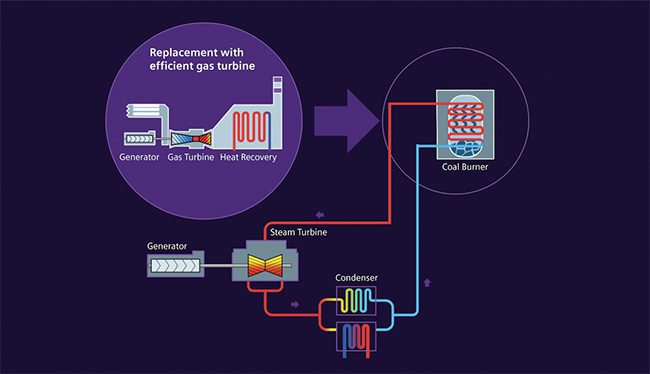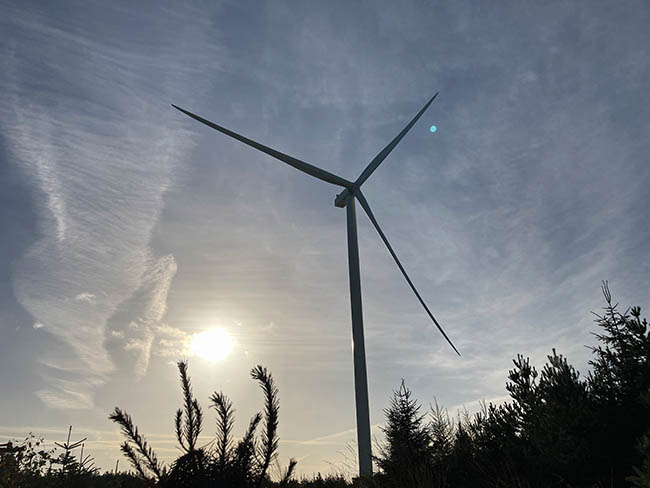Repowering Provides New Purpose for Existing Plants
The benefits of repowering—cost savings from upgraded performance, and utilizing existing infrastructure—make it an important part of the energy landscape.
Repowering is occurring in both thermal and renewable power plants, as new technologies make older facilities new again. The practice involves replacing aging generating units at thermal plants with new, higher-capacity turbines, or retrofitting a renewable energy site with more efficient components—in both cases, significantly increasing a power plant’s output while extending the facility’s life.
At a thermal plant, it could be completing a fuel switch from coal to natural gas, or even—as some experts told POWER—replacing coal generation with output from small modular nuclear reactors. A wind farm operator could erect taller, more efficient wind turbines to increase productivity. The owner of a solar farm may install new, more advanced solar panels to increase the performance of the array.
“Reuse, repower, repurpose—all that makes a lot of sense, as those approaches are sustainable, faster to implement, and cheaper in comparison to greenfield solutions since you can reuse permits, materials [such as] for foundations or housing or infrastructure,” said Annika Gerloff, a Siemens Energy executive in Germany with experience in brownfield projects. Gerloff told POWER, “In the long run, many power plants will become hybrid plants, laying the foundation for a new energy system. They’ll connect and integrate various functional elements, such as different means of generating power. For example, renewable power sources like solar and wind, and gas turbines capable of burning 100% green hydrogen that’s produced by electrolyzers using clean energy.”
 |
|
1. Switching a coal-fired power plant to burn natural gas has been a frequent practice for power plant operators in recent years, enabling utility-scale plants to continue operating rather than being retired. Courtesy: Siemens Energy |
Repowered projects often offer further cost-saving advantages, relative to new-build or greenfield developments, because they can use existing grid connections and transmission infrastructure, as Gerloff noted. That includes replacing coal-fired boilers with gas-fired turbines (Figure 1).
“Hybrid power plants will also include energy storage systems like hydrogen, batteries, and thermal storage, and applications for supplying grid stability services,” Gerloff said. “One main advantage of building a hybrid power plant on an existing infrastructure is that they offer significant cost savings and reduced lifecycle CO2 emissions, and they also enable synergies between new and existing assets.”
Wind and Solar Farms
Repowering of wind farms, among the most common forms of the practice, is extending the operational life of projects worldwide. GE Renewable Energy’s Cypress onshore wind turbine was recently selected for a repowering project at Windplan Groen, the largest onshore wind farm in the Netherlands. GE will provide 26 Cypress 6.0-164 wind turbines (Figure 2), the company’s most powerful onshore turbine, to repower part of the project, located in the Flevoland province. The turbines will be installed at three wind parks that are expected to be completed in 2023, and the agreement includes a 25-year full-service contract.
 |
|
2. GE will provide 26 Cypress 6.0-164 wind turbines for a wind farm repowering project in the Netherlands. Courtesy: GE Renewable Energy |
Gilan Sabatier, GE’s COO of Onshore Wind International, said: “We are delighted to have been selected for the Windplan Groen project with our latest and most powerful onshore wind turbine. This will significantly increase the wind farm’s energy output and deliver even more affordable and sustainable renewable energy to the Netherlands. The repowering of older wind farms with more powerful turbines will play a significant role in achieving Europe’s goal of becoming carbon neutral by 2050.”
Industry analysts have said about 40 GW of Europe’s wind turbines will be at least 20 years old by 2025, and the sector is looking a repowering to meet both renewable energy targets and decarbonization goals. “Europe is now starting to dismantle its first generation of onshore wind turbines,” said Giles Dickson, CEO of WindEurope, at a recent conference on end-of-life strategies for aging wind farms. “It is crucial that we keep the sites going and replace the old turbines with new ones. They’re the sites with the best wind conditions, and the wind farms have become a well-established part of the local economy.”
A recently completed project in West Virginia, at Clearway Energy Group’s Pinnacle Wind Farm, provides a look at the tangible benefits of repowering. Clearway said putting 23 new, upgraded turbines at the Pinnacle site enables the farm to produce 16% more energy than the previous turbines. The project created about 50 full-time construction jobs, and will increase Clearway’s tax payments to Mineral County by as much as $200,000 in the first year of operation. The company said the wind farm also will contribute $3.7 million in West Virginia business and occupancy taxes over its newly extended operating life.
A WindEurope analysis of about 140 projects repowered in Europe also shows the benefits of updating turbine technology. On average, the number of turbines in those wind projects decreased by 27%. Meanwhile, installed generation capacity was doubled, and electricity output tripled.
Repowering solar farms also is being done with an eye toward improved generation capacity and power production, particularly due to the rapid pace of technological advancements in the solar sector for photovoltaic modules, inverters, and trackers. Repowering often focuses on inverters because they offer the greatest potential for performance upgrades, as they convert direct current electricity that solar panels generate to alternating current electricity for use by the grid. Inverters, in addition to converting power, also are responsible for grid services, control, and monitoring.
Germany-based BayWa r.e. is known for its solar repowering efforts, in Europe and elsewhere. The company last year, in announcing projects in the UK, noted how modernizing and optimizing solar power plants can “considerably improve [solar power] availability and production, and thus offer significant improved return on investment,” according to Natasha Kumar, managing director for BayWa r.e. Operation Services. The company said repowering can extend the design lifespan of a solar array by 20 years or more.
Repurposing Coal Plants with Nuclear Power
A UK-headquartered international design company, Bryden Wood, is working with TerraPraxis, a non-profit organization focused on action for climate and energy, on a “Repowering Coal” initiative to help countries meet net-zero emissions targets by replacing coal-fired boilers at existing power plants with Generation IV advanced modular reactors (AMRs). Bryden Wood has created a new design and construction solution that the group says would make such a program possible at scale and speed, in part by deploying a new digital platform.
“We’ve developed a new, standardized and optimized approach that’s completely different to previous infrastructure thinking,” Martin Wood, co-founder of Bryden Wood, told POWER. “We’re building the market for AMRs at the same time as the product itself is being developed. The digital tools we’re creating will enable us to have a huge number of projects, across multiple sites, ready to go as soon as the reactors are approved. Speed and agility have never been so important.”
Bryden Wood, in addition to joining with TerraPraxis, is working with the University of Buffalo, the Massachusetts Institute of Technology, Microsoft, and KPMG to standardize and optimize processes, along with building and engineering systems. The groups said the project to replace coal units with small reactors would first be deployed in the U.S.
Kirsty Gogan, founder and managing partner of TerraPraxis, told POWER, “By sustaining permanent high-quality jobs for communities, repowered coal plants reduce the negative impacts on communities to public and political support for a just transition. The challenge is not only to build enough clean electricity generation to power the world, but to do so quickly while building the infrastructure required to decarbonize end-use sectors such as heat, industry, and transport.”
Many coal plants have been retrofitted to burn natural gas over the past decade-plus; a repowering with nuclear technology presents new design and regulatory challenges.
“Coal plants vary widely and developing a new design for each plant would be complex, costly, and slow,” said Wood. “Rather than thousands of individual projects, we must have a unified approach where the design is simplified and standardized to make this plan a reality as quickly as possible. The plan is to replace the existing boiler with a standardized advanced heat source (AHS) that fits into a standardized facility. A new heat transfer and storage system will run between the existing coal plant and the AHS, which is itself in two parts: the reactor within a modular, component-based enclosure, and another enclosure with support systems. A modular heat transfer system and associated energy storage will allow the plant to efficiently match reactor output with generation demand.”
Gogan acknowledged the regulatory challenges, and said, “Our building system is designed to reduce regulatory scope by firstly separating the power island from the heat island via thermal energy storage. This means that no accident propagation is possible from the power island to the heat island, and that the power island has no nuclear safety requirements. Secondly, safety by design characteristics of the advanced heat sources means that safety is achieved with no active safety systems. This reduces complexity and means that all safety-related systems can be combined in one reactor building. The relatively small reactor building, assembled from pre-fabricated components, therefore becomes the only safety-related building. As part of their initial license review, the regulator will have already reviewed this exact configuration and its associated building designs.”
Gogan said repowering is a way “to accelerate and de-risk global decarbonization,” while also supporting an “affordable clean energy provision on existing sites utilizing existing transmission.” She said it provides “the opportunity to reduce the overall scale of investment required to enable the clean energy transition.”
It also could help the energy workforce, as plants are repowered with new technology and able to remain in operation. “Repurposing the majority of existing coal plant sites and infrastructure, including transmission, and maintaining the workforce employed today, dramatically reduces the investments and effort otherwise required to site, plan, build, and connect new infrastructure,” she said.
—Darrell Proctor is a senior associate editor for POWER (@POWERmagazine).